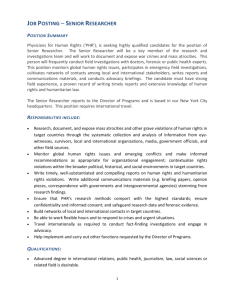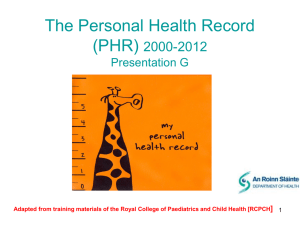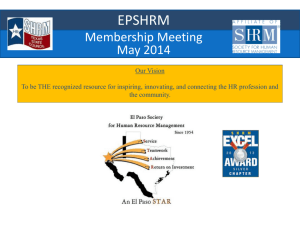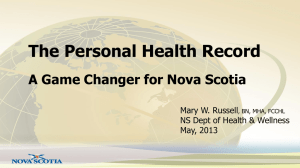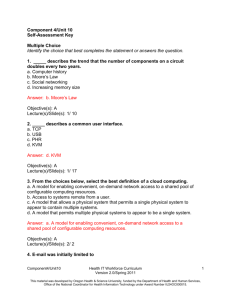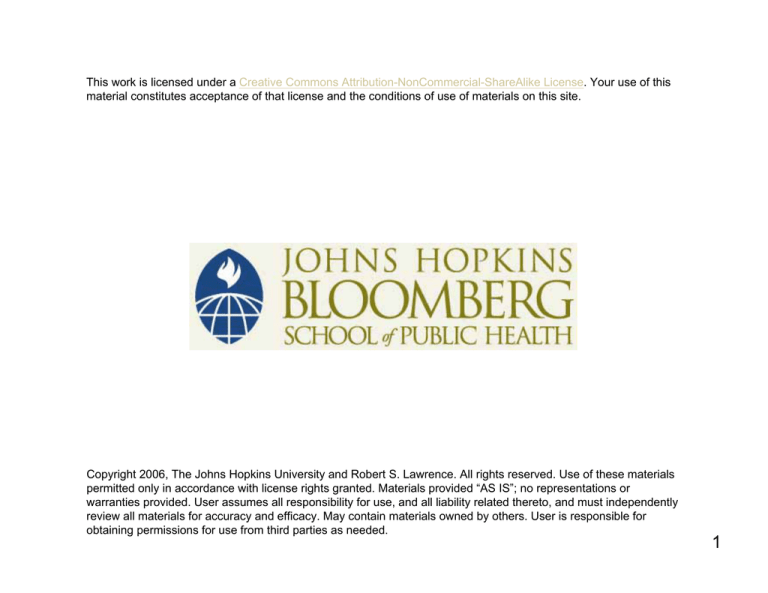
This work is licensed under a Creative Commons Attribution-NonCommercial-ShareAlike License. Your use of this
material constitutes acceptance of that license and the conditions of use of materials on this site.
Copyright 2006, The Johns Hopkins University and Robert S. Lawrence. All rights reserved. Use of these materials
permitted only in accordance with license rights granted. Materials provided “AS IS”; no representations or
warranties provided. User assumes all responsibility for use, and all liability related thereto, and must independently
review all materials for accuracy and efficacy. May contain materials owned by others. User is responsible for
obtaining permissions for use from third parties as needed.
1
Health and Human Rights
Principles for Refugee Health
Robert S. Lawrence, MD
Johns Hopkins University
Section A
Origin, Definition, and
Role of Human Rights
3
Origin of Human Rights
Ù The term human rights came into
common use only after World War II
and the founding of the United Nations
in 1945
Origin of Human Rights
Ù It replaces the concept of natural
rights, which emerged from the
philosophy of Greek stoicism
– The concept of natural rights lost
its utility when natural law became
controversial in the 19th and early
20th centuries because of its
misapplication in social Darwinism
5
Origin of Human Rights
Ù Also replaces the
Enlightenment
concept of “the
Rights of Man”
Ù Which were not
widely understood
to include “the
Rights of Women”
Continued
6
Origin of Human Rights
Ù The horrors of Nazi Germany
reaffirmed the basic idea of universal
human rights
Ù Human rights came into its own over
the last 55 years
7
Human Rights Definition:
Five Basic Components
1. Human rights represent demands of
individuals and groups for the sharing
of power, wealth and other values.
Respect, reciprocal tolerance, and
mutual forbearance are fundamental
to human rights.
– Human rights limit state power;
states, through the rule of law,
protect the rights of individuals but
do not convey or endow rights of
Continued
individuals
8
Human Rights Definition:
Five Basic Components
2. Human rights partake of both legal
and moral orders; they express both
the “is” and the “ought” in human
affairs
– Example of “is”: Legal proscription
against torture
– Example of “ought”: Rights in
social, cultural, and economic
domain
Continued
9
Human Rights Definition:
Five Basic Components
3. Human rights are universal, equally
possessed by all humans everywhere
Continued
10
Human Rights Definition:
Five Basic Components
4. Human rights are qualified by the
limitation that the rights of any
particular individual or group are
restricted as much as is necessary to
secure comparable rights of others
– Sometimes designated as
prima facie rights
Continued
Human Rights Definition:
Five Basic Components
5. Human rights refer to fundamental
rights as distinct from nonessential
claims or goods
– Some would limit human rights to
core rights to life and equal
freedom of opportunity and rule
out “mere wants”
12
Role of Human Rights
Ù “While knowing the rules does not
assure victory, the more they are
known, the more likely they can protect
those in greatest need”
— J. Paul Martin, Executive Director
Center for the Study of Human Rights
Columbia University
Continued
Role of Human Rights
Ù The more we can communicate the
rules that govern relationships
between states and oversee the
obligations of states to their citizens,
the more opportunity we have to
advance the rights of people
everywhere
14
Section B
The United Nations and
International Human Rights Laws
15
Formation of the United Nations
Ù Formed after World War II, where more
than 60 million people were killed (about
6 million Jews in the holocaust)
16
United Nations Charter
Ù United Nations Charter signed on June
26, 1945; which entered into force
October 24, 1945
Ù …”to reaffirm faith in fundamental
human rights, in the dignity and worth
of the human person, in the equal
rights of men and women, and of
nations large and small,” …
Continued
17
United Nations Charter
Ù …”to establish conditions under which
justice and respect for the obligations
arising from treaties and other sources
of international law can be maintained,
and to promote social progress and
better standards of life in larger
freedom, and for these ends, to
practice tolerance and live together in
peace with one another as good
neighbors”...
Continued
18
United Nations Charter
Ù Generated a spirit of optimism and
many believed that humans had
learned the bitter lessons of
intolerance
– and were ready to embrace a new
era of giving full recognition to
human rights
19
Universal Declaration
of Human Rights
Ù Adopted by United Nations General
Assembly on December 10, 1948
– Represented aspirations of
founders of the United Nations
– Staked out domain for human
rights
20
Article 3
Ù Everyone has the right to
– Life
– Liberty
– And security of person
21
Article 22
Ù Everyone, as a member of society, has
the right to social security and is
entitled to realization, through national
effort and international cooperation
and in accordance with the
organization and resources of each
state, of the economic, social and
cultural rights indispensable for his
dignity and the free development of his
personality
22
Article 25
1. Everyone has the right to a standard
of living adequate for the health and
well-being of himself and of his family,
including food, clothing, housing,
medical care, and necessary social
services
Continued
23
Article 25
– … and the right to security in the
event of unemployment, sickness,
disability, widowhood, old age, or
other lack of livelihood in
circumstances beyond his control
Continued
24
Article 25
2. Motherhood and childhood are entitled
to special care and assistance
– All children, whether born in or out
of wedlock, shall enjoy the same
social protection
25
United Nations Covenants
UN proposed two covenants on
December 16, 1966
1. International Covenant on Economic,
Social, and Cultural Rights (not ratified
by USA)
Continued
26
United Nations Covenants
2. International Covenant on Civil and
Political Rights signed by USA
– Gave people the freedom to vote,
freedom of free movement, and
freedom of assembly
Continued
27
United Nations Covenants
Ù Several rights in the International
Covenant on Economic, Social, and
Cultural Rights are relevant to refugee
and displaced populations, e.g.
Article 12
28
Article 12
1. The States Parties to the present
Covenant recognize the right of
everyone to the enjoyment of the
highest attainable standard of physical
and mental health
Continued
29
Article 12
2. The steps to be taken by the States
Parties to the present Covenant to
achieve the full realization of this right
shall include those necessary for:
a. The provision for the reduction of
the stillbirth rate and of infant
mortality and for the healthy
development of the child
Continued
30
Article 12
b. The improvement of all aspects of
environmental and industrial
hygiene
Continued
31
Article 12
c. The prevention, treatment, and
control of epidemic, endemic,
occupational, and other diseases
Continued
32
Article 12
d. The creation of conditions which
would assure to all medical service
and medical attention in the event
of sickness
33
Human Rights Laws and
Displaced Populations
Ù The International Covenant on
Economic, Social, and Cultural Rights
has given the world community the
implicit obligation to protect and
defend refugee populations
Ù States that have signed this covenant
have an obligation to protect and
assist Internally Displaced Persons
Ù The realities of mass displacement are
incompatible with human rights laws
34
Section C
Role of Health Workers
and Human Rights Groups
35
Health and Human Rights
Ù Health professionals are often among
the first witnesses of the physical and
psychological harm that human rights
violations cause to individuals and
communities
– Executions
– Mutilations
– Forensic examinations
Continued
36
Health and Human Rights
Ù Health professionals exposed to
complications and consequences of
lack of food, security, decent shelter,
etc., become advocates for affected
populations without directly relating it
to human rights
Continued
37
Health and Human Rights
Ù For the past thirty years, the health
care community has mobilized itself to
– Protest violations of human rights
– Document their health
consequences
– Examine its own role in
perpetrating or ending these
abuses
38
Human Rights Violations
by Health Professionals
Ù Situations where health professionals
have been complicit with gross human
rights violations
Continued
39
Human Rights Violations
by Health Professionals
Ù District Surgeons in South Africa watched
Steve Biko die of wounds inflicted during
torture
– Exposed by Wendy Orr
Continued
40
Human Rights Violations
by Health Professionals
Ù Chilean physicians complicit in torture
of victims
– Four physicians later stripped of
membership in Colegio Medico,
ending their ability to practice
41
Human Rights Groups
Ù Several human rights groups have
emerged
– Amnesty International
– Human Rights Watch
– Medecins Sans Frontieres
– Physicians for Human Rights
– Lawyers Committee for Human
Rights
42
Physicians for Human Rights
Ù The mandate of PHR is largely defined
by the rights enunciated in the
Universal Declaration of Human Rights
and subsequent conventions and
protocols
Continued
43
Physicians for Human Rights
Ù PHR also uses Geneva Conventions
of 1949 and Additional Protocols of
1977, which further define:
– The protections and guarantees of
medical neutrality
– The protection of patients and
health professionals
– The right to access to care and
humane treatment of civilians
44
Origin of Geneva Conventions
Ù In 1870, the Battle of Solferino in
Northern Italy left many wounded and
dying soldiers without aid
Ù Henry Dunant, shocked by sight, on
his return to Geneva called three
colleagues and together formed the
ICRC and articulated the first Geneva
Convention
45
Geneva Conventions
1st
Medical aid for wounded
Convention combatants and medical
neutrality of participants
2nd
Extended aid to sailors
Convention wounded in naval battle
3rd
Protection and medical care
Convention for prisoners of war (POWs)
4th
Protection and medical care
Convention for civilians in armed conflict
46
Additional Protocols of 1977
Ù Four Additional Protocols later
formulated and verbally honored by all
nations
– Frequently breached, e.g. the
Balkans
47
PHR Philosophy
Ù The decision to create an organization of
health professionals to work on behalf of
human rights arose from two insights
48
PHR Philosophy: First Insight
Ù “First was the recognition that many
human rights violations had significant
health consequences, which include:
Continued
49
PHR Philosophy: First Insight
– Physical and psychological trauma
of individual victims of violence,
torture, and rape
– Breaches of medical neutrality
– Forced deportations
– Use of indiscriminate weapons
– Mass executions and other violent
acts that affect entire populations
…
Continued
50
PHR Philosophy: First Insight
Ù … the purposeful destruction of health
facilities and essential civilian
infrastructures leads to slower forms of
death
– From epidemic infectious disease
– Untreated chronic disease
– Or starvation”
51
PHR Philosophy: Second Insight
Ù Health professionals are uniquely
situated to collect the medical
documentation that provides concrete
evidence of human rights violations
– This ranges from physical
examination of individuals to forensic
exhumations of mass graves
– PHR members H. Jack Geiger and
Robert Cook-Deegan
52
PHR Methods of Work
Ù PHR conducts direct documentation
through fact-finding missions (sent over
100 missions to 48 nations)
Ù Provides advocacy
– Reports, journal articles, press
releases
– Meetings with foreign government
officials, U.S. state department
– Letter-writing campaigns
– Coalition-building
Continued
53
PHR Methods of Work
Ù PHR led the coalition to ban
landmines, which led to the
international law to ban landmines
– Signed by over 100 countries
(not U.S.)
– PHR shared Nobel Peace Prize in
1998 with Jody Williams and five
other NGOs
Continued
54
PHR Methods of Work
Ù PHR conducts education and training
and responds to challenge of making
international human rights relevant to
the health professional
55
Section D
Application of Human Rights
Principles to Developing Policies
and Procedures for Managing CHE
56
Assessing Human Rights Impact
Ù Guidelines for assessing human rights
impact of any proposed policy or
intervention have been developed by
Lawrence Gostin and the late
Jonathan Mann
Continued
57
Assessing Human Rights Impact
Clarify the Public
Health Purpose
A. What are we trying to do?
B. Are we trying to prevent
continuation of abuses?
C. What is the purpose of
preventing epidemics?
58
Assessing Human Rights Impact
Evaluate Policy
Effectiveness
A. Is magnitude well defined?
B. Will intervention work?
C. Consider alternatives?
Continued
59
Assessing Human Rights Impact
A. Avoid under-inclusion
B. Avoid over-inclusion of
particular sub-groups
Is the Policy
Well Targeted?
Continued
60
Assessing Human Rights Impact
A. Consider international
law
Examine Human
Rights Burdens
Continued
61
Assessing Human Rights Impact
Human rights divided into two categories:
1. Derogable rights: Can be temporarily
suspended—e.g., freedom of
movement can be removed during
epidemics
2. Nonderogable rights: Constant—e.g.,
freedom of speech, freedom from
torture
Continued
62
Assessing Human Rights Impact
Is Policy Least
Restrictive A. Does it preserve maximum
Alternative? freedom for target population
B. If a coercive measure is most
effective and least restrictive,
confirm it reduces a
“significant risk” of harm
C. If coercive measures are
essential, then guarantee fair
procedures
63
Permissible Under-Inclusion
Population A = All
adolescents at risk for
STDs and unwanted
pregnancy who could
benefit from sex
education and counseling
A
B
Population B = All
adolescents in institutional
settings—e.g., prisons,
foster homes, and mental
hospitals
Continued
64
Permissible Under-Inclusion
Proposed policy:
Provide
comprehensive sex
education and condom
distribution only to
Population B
A
B
Permissible since B
represents subset of
vulnerable population
at higher risk
65
Impermissible Under-Inclusion
A
B
Proposed policy:
Isolation during active
phase of tuberculosis
and DOT during the
entire course of
treatment of persons
in Population B
Continued
66
Impermissible Under-Inclusion
Population A = All
persons diagnosed
with active
tuberculosis
A
B
Population B = All
persons without a
permanent
address diagnosed
with active
tuberculosis
Continued
67
Impermissible Under-Inclusion
Proposed policy:
Isolation during active
phase of tuberculosis and
DOT during the entire
course of treatment of
persons in Population B
A
B
Policy not permissible
since anyone with active
TB needs DOT to get
maximum benefit of
treatment
68
Over-Inclusion
Proposed policy:
Quarantine of all
HIV-positive
persons in the
country
A
A
BB
Continued
69
Over-Inclusion
Population A =
All persons with
HIV in the country
A
A
BB
Population B =
All persons with
HIV who engage
in high-risk
behavior
70
Over-Inclusion
Proposed policy:
Quarantine of all
HIV-positive persons
in the country
A
A
BB
Inappropriate uniform
application of a policy
that should only
target the high-risk
population
71
Under and Over-Inclusion
Proposed policy:
Screening and
excluding those who
test positive for HIV
infection, targeted to
Population B only
A
B
C
D
Continued
72
Under and Over-Inclusion
A
B
C
D
Population A = All
foreigners entering the
country
Population B = All
foreigners from Region X
Population C = All
foreigners from Region X
with high-risk behaviors
Population D = All
foreigners from outside
Region X with high-risk
behaviors
Continued
73
Under and Over-Inclusion
Proposed policy:
Screening and excluding
those who test positive
for HIV infection,
targeted to Population B
only
A
B
C
D
Under-inclusion is D
Over-inclusion is B;
Policy should only target
Populations C and D
74
Challenges of Refugees with
Regard to Human Rights
Ù Displaced people vulnerable to many
problems: Lack of shelter, food, health,
etc.
Ù Problems compounded by breakdown
of rule of law, power struggles within
displaced population
Ù Under threat from abusive government
Ù Needs for human rights protection
greater than for stable population
75
AIDS Epidemic a Human
Rights Challenge
Ù Early AIDS victims included
homosexuals, IV drug users, and their
partners
– All marginalized and stigmatized
– Vulnerable to neglect, abuse by
society
Ù Negative comments
– “They deserve what they get”
– “God’s retribution for sinful acts”
76
Linking Health Status
to Human Rights
Ù In a situation where a disease can
spread more easily in a marginalized
population whose rights have been
systematically denied, poor health
status and failure to protect and
recognize human rights are directly
linked
Continued
77
Linking Health Status
to Human Rights
Ù While refugees differ from early AIDS
victims, they are often marginalized,
have same vulnerability to disease,
same difficulty in access to basic
needs
Ù Direct link between special needs of
refugees and special attention to
protecting their human rights
78
Human Rights Web Sites
Ù
Ù
Ù
Ù
Ù
Ù
www.un.org
www.hri.org
www.hrw.org
www.phrusa.org
www.hrweb.org
www.ai.org
79

